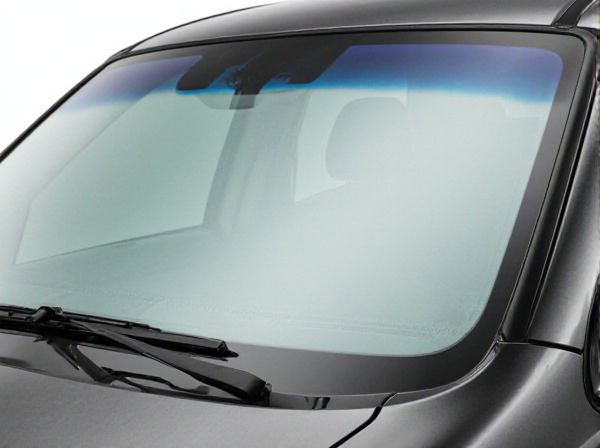
Photo illustration: Shaded Band vs Non-Shaded Band Windshield
A shaded band windshield features a tinted strip at the top that reduces glare from the sun, enhancing visibility and comfort while driving. Non-shaded band windshields lack this tint, offering an unobstructed view but potentially causing more eye strain in bright conditions. Choosing a shaded band windshield can improve your driving experience by minimizing glare without compromising overall visibility.
Table of Comparison
| Feature | Shaded Band Windshield | Non-Shaded Band Windshield |
|---|---|---|
| Sun Glare Reduction | Yes, reduces glare from sun | No sun glare reduction |
| UV Protection | Offers enhanced UV filtering | Standard UV protection only |
| Visual Comfort | Improved comfort for driver and passengers | Standard visual comfort |
| Aesthetic | Dark tinted band at the top edge | Transparent edge with no tint |
| Cost | Higher price due to added features | Lower price, basic design |
| Common Use | Preferred for regions with strong sunlight | Used in general everyday driving conditions |
Introduction to Shaded and Non-Shaded Band Windshields
Shaded band windshields feature a tinted strip along the top edge that reduces glare from sunlight, improving driver comfort and visibility during bright conditions. Non-shaded band windshields lack this tinted area, offering a consistent level of light transmission across the entire glass surface. Choosing between shaded and non-shaded bands depends on driving environments and personal preference for glare reduction versus unobstructed sightlines.
What Is a Shaded Band Windshield?
A shaded band windshield features a tinted strip at the top edge that reduces glare from direct sunlight, improving driver comfort and visibility. This band is typically made from colored glass or a gradient film, designed to block harsh light without obstructing the overall view. Non-shaded band windshields lack this tinted strip, which can result in increased glare during bright conditions but may offer a clearer view in low-light situations.
Features of a Non-Shaded Band Windshield
A non-shaded band windshield features a uniform tint across the entire glass surface, providing consistent visibility without any gradient or color change at the top. This type of windshield allows maximum light transmission, reducing any visual distortion or color shading that could affect driver perception. It is ideal for clear and unobstructed views in various lighting conditions, enhancing safety during daytime and nighttime driving.
Key Differences Between Shaded and Non-Shaded Band Windshields
Shaded band windshields feature a tinted strip along the top edge designed to reduce glare from sunlight, enhancing driver visibility and comfort during bright conditions. Non-shaded band windshields lack this tinted area, allowing maximum light transmission but potentially increasing glare exposure for the driver. The key difference lies in the function of the shaded band, which acts as a visual barrier to intense sunlight, while non-shaded windshields offer a clearer, uninterrupted view without tinting.
Benefits of a Shaded Band Windshield
A shaded band windshield reduces glare from direct sunlight, enhancing driver visibility and safety, especially during sunrise and sunset. It helps maintain cooler cabin temperatures by blocking UV rays, which protects interior materials from fading and degradation. This feature also minimizes eye strain for drivers, contributing to a more comfortable and focused driving experience.
Potential Drawbacks of Shaded Bands
Shaded band windshields can create glare or distortion near the top edge, potentially reducing driver visibility in certain lighting conditions. These bands may interfere with sensor or camera function in advanced driver-assistance systems (ADAS), affecting safety features like lane departure warnings. Furthermore, the added tint can complicate windshield repairs and replacements, increasing maintenance costs compared to non-shaded band windshields.
Impact on Driver Visibility and Safety
Shaded band windshields improve driver visibility by reducing glare from direct sunlight, especially during dawn or dusk, which enhances safety by minimizing eye strain and distractions. Non-shaded band windshields lack this protective tint, often causing increased glare that can impair the driver's vision and reaction time in bright conditions. Choosing a shaded band windshield contributes to safer driving by maintaining clearer sightlines and reducing the risk of accidents caused by sudden light exposure.
Aesthetic Considerations and Vehicle Design
Shaded band windshields enhance vehicle aesthetics by providing a sleek transition between glass and roofline, reducing glare and improving driver comfort while maintaining design continuity. Non-shaded band windshields offer a clean, unobstructed view that emphasizes simplicity and minimalism in vehicle design, often preferred in modern, streamlined car models. Choosing between shaded and non-shaded bands impacts the overall visual appeal and complements the vehicle's architectural style and lighting integration.
Choosing Between Shaded and Non-Shaded Band Windshields
Choosing between shaded and non-shaded band windshields depends on factors like glare reduction and aesthetic preference. Shaded band windshields enhance driver visibility by reducing sun glare, particularly during sunrise and sunset, while also contributing to vehicle design. Non-shaded windshields offer unobstructed views, ideal for drivers prioritizing maximum light transmission and clarity.
Conclusion: Which Windshield Type Is Right for Your Vehicle?
Choosing between a shaded band and a non-shaded band windshield depends on your driving conditions and comfort preferences. A shaded band windshield reduces glare from the sun, improving visibility and reducing eye strain during bright daylight, making it ideal for drivers in sunny or high-glare environments. Non-shaded band windshields offer a clear, unobstructed view, which might be preferable in areas with frequent low light or for those who prioritize an unfiltered windshield experience.
 caratoz.com
caratoz.com